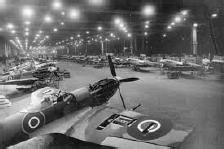 DID - U - KNOW DID - U - KNOW
 by Facia Nearside by Facia Nearside
 By the mid-1930s it was becoming obvious that war was once again on the horizon. The British government realized expertise within the motor industry was the key to turning out the complex machines that would be needed for the war effort. In a bold and innovative plan to maximize this production capability, the Shadow Factory Programme was formed. By the mid-1930s it was becoming obvious that war was once again on the horizon. The British government realized expertise within the motor industry was the key to turning out the complex machines that would be needed for the war effort. In a bold and innovative plan to maximize this production capability, the Shadow Factory Programme was formed.
 The term “shadow factory” had nothing to do with secrecy. It described duplicated facilities in the shadow of their similar motor industry operation and under direct control of the parent company. During the ?rst phase of the project in 1936 & 37 new factories were built beside existing ones. This facilitated sharing manpower and knowledge as well as making use of existing supply networks. During the second phase in 1938 & 39 building locations were farther from existing industrial centers to reduce vulnerability. The term “shadow factory” had nothing to do with secrecy. It described duplicated facilities in the shadow of their similar motor industry operation and under direct control of the parent company. During the ?rst phase of the project in 1936 & 37 new factories were built beside existing ones. This facilitated sharing manpower and knowledge as well as making use of existing supply networks. During the second phase in 1938 & 39 building locations were farther from existing industrial centers to reduce vulnerability.

 Castle Bromwich Aircraft Factory, which turned out thousands of Spitfires, now produces Jaguar Sports Cars.
Castle Bromwich Aircraft Factory, which turned out thousands of Spitfires, now produces Jaguar Sports Cars.
|
 In a move which seems counterintuitive, German dignitaries were actually given tours of the shadow factories before the war. This was intended to be a deterrent by showing how well the country was prepared against attack. In a move which seems counterintuitive, German dignitaries were actually given tours of the shadow factories before the war. This was intended to be a deterrent by showing how well the country was prepared against attack.
 There was no doubt the Shadow Factory Programme was an important piece of the puzzle in winning the war. What might not be as obvious is the role it played in kick starting the British auto industry at war’s end. Modern tools along with automated production had been key to realizing required goals for the war effort. Now this was all available in large modern facilities for automobile production. Although most shadow factories are long gone or converted to other uses, some still exist. The Solihull Shadow Factory, which built Bristol aircraft engines, is now the center of aluminum body technology for Land Rover, and the Castle Bromwich Aircraft Factory, which turned out thousands of Spit?res, now produces Jaguar Sports Cars. There was no doubt the Shadow Factory Programme was an important piece of the puzzle in winning the war. What might not be as obvious is the role it played in kick starting the British auto industry at war’s end. Modern tools along with automated production had been key to realizing required goals for the war effort. Now this was all available in large modern facilities for automobile production. Although most shadow factories are long gone or converted to other uses, some still exist. The Solihull Shadow Factory, which built Bristol aircraft engines, is now the center of aluminum body technology for Land Rover, and the Castle Bromwich Aircraft Factory, which turned out thousands of Spit?res, now produces Jaguar Sports Cars.
Reprinted from British Boots & Bonnets Chronicle — February 2019 issue.
|